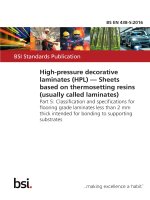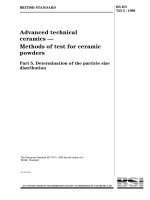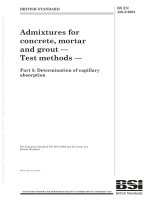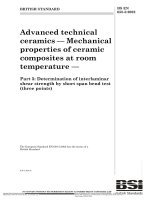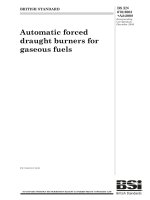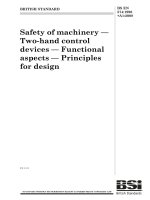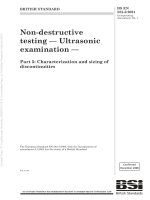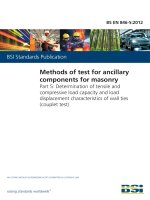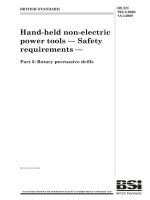Bsi bs en 61158 5 17 2008
Bạn đang xem bản rút gọn của tài liệu. Xem và tải ngay bản đầy đủ của tài liệu tại đây (472.36 KB, 60 trang )
BS EN 61158-5-17:2008
BSI British Standards
Industrial communication
networks — Fieldbus
specifications —
Part 5-17: Application layer service
definition — Type 17 elements
NO COPYING WITHOUT BSI PERMISSION EXCEPT AS PERMITTED BY COPYRIGHT LAW
raising standards worldwide™
BRITISH STANDARD
BS EN 61158-5-17:2008
National foreword
This British Standard is the UK implementation of EN 61158-5-17:2008. It is
identical with IEC 61158-5-17:2007. Together with all of the other sections of
BS EN 61158-5, it supersedes BS EN 61158-5:2004 which is withdrawn.
The UK participation in its preparation was entrusted to Technical Committee
AMT/7, Industrial communications - Process measurement and control,
including Fieldbus
A list of organizations represented on this committee can be obtained on
request to its secretary.
This publication does not purport to include all the necessary provisions of a
contract. Users are responsible for its correct application.
Compliance with a British Standard cannot confer immunity from
legal obligations.
This British Standard was published under the authority of the Standards
Policy and Strategy Committee on 31 January 2009.
© BSI 2009
ISBN 978 0 580 61602 0
ICS 25.040.40; 35.100.70
Amendments issued since publication
Amd. No.
Date
Text affected
BS EN 61158-5-17:2008
EUROPEAN STANDARD
EN 61158-5-17
NORME EUROPÉENNE
March 2008
EUROPÄISCHE NORM
ICS 35.100.70; 25.040.40
Partially supersedes EN 61158-5:2004
English version
Industrial communication networks Fieldbus specifications Part 5-17: Application layer service definition Type 17 elements
(IEC 61158-5-17:2007)
Réseaux de communication industriels Spécifications des bus de terrain Partie 5-17: Définition des services
des couches d'application Eléments de type 17
(CEI 61158-5-17:2007)
Industrielle Kommunikationsnetze Feldbusse Teil 5-17: Dienstfestlegungen
des Application Layer
(Anwendungsschicht) Typ 17-Elemente
(IEC 61158-5-17:2007)
This European Standard was approved by CENELEC on 2008-02-01. CENELEC members are bound to comply
with the CEN/CENELEC Internal Regulations which stipulate the conditions for giving this European Standard
the status of a national standard without any alteration.
Up-to-date lists and bibliographical references concerning such national standards may be obtained on
application to the Central Secretariat or to any CENELEC member.
This European Standard exists in three official versions (English, French, German). A version in any other
language made by translation under the responsibility of a CENELEC member into its own language and notified
to the Central Secretariat has the same status as the official versions.
CENELEC members are the national electrotechnical committees of Austria, Belgium, Bulgaria, Cyprus, the
Czech Republic, Denmark, Estonia, Finland, France, Germany, Greece, Hungary, Iceland, Ireland, Italy, Latvia,
Lithuania, Luxembourg, Malta, the Netherlands, Norway, Poland, Portugal, Romania, Slovakia, Slovenia, Spain,
Sweden, Switzerland and the United Kingdom.
CENELEC
European Committee for Electrotechnical Standardization
Comité Européen de Normalisation Electrotechnique
Europäisches Komitee für Elektrotechnische Normung
Central Secretariat: rue de Stassart 35, B - 1050 Brussels
© 2008 CENELEC -
All rights of exploitation in any form and by any means reserved worldwide for CENELEC members.
Ref. No. EN 61158-5-17:2008 E
BS EN 61158-5-17:2008
EN 61158-5-17:2008
-2-
Foreword
The text of document 65C/475/FDIS, future edition 1 of IEC 61158-5-17, prepared by SC 65C, Industrial
networks, of IEC TC 65, Industrial-process measurement, control and automation, was submitted to the
IEC-CENELEC parallel vote and was approved by CENELEC as EN 61158-5-17 on 2008-02-01.
This and the other parts of the EN 61158-5 series supersede EN 61158-5:2004.
With respect to EN 61158-5:2004 the following changes were made:
– deletion of Type 6 fieldbus for lack of market relevance;
– addition of new fieldbus types;
– partition into multiple parts numbered 5-2, 5-3, …, 5-20.
The following dates were fixed:
– latest date by which the EN has to be implemented
at national level by publication of an identical
national standard or by endorsement
(dop)
2008-11-01
– latest date by which the national standards conflicting
with the EN have to be withdrawn
(dow)
2011-02-01
NOTE Use of some of the associated protocol types is restricted by their intellectual-property-right holders. In all cases, the
commitment to limited release of intellectual-property-rights made by the holders of those rights permits a particular data-link layer
protocol type to be used with physical layer and application layer protocols in type combinations as specified explicitly in the
EN 61784 series. Use of the various protocol types in other combinations may require permission from their respective
intellectual-property-right holders.
Annex ZA has been added by CENELEC.
__________
Endorsement notice
The text of the International Standard IEC 61158-5-17:2007 was approved by CENELEC as a European
Standard without any modification.
In the official version, for Bibliography, the following notes have to be added for the standards indicated:
IEC 61158-6-17
NOTE Harmonized as EN 61158-6-17:2008 (not modified).
IEC 61784-1
NOTE Harmonized as EN 61784-1:2008 (not modified).
IEC 61784-2
NOTE Harmonized as EN 61784-2:2008 (not modified).
__________
BS EN 61158-5-17:2008
-3-
EN 61158-5-17:2008
Annex ZA
(normative)
Normative references to international publications
with their corresponding European publications
The following referenced documents are indispensable for the application of this document. For dated
references, only the edition cited applies. For undated references, the latest edition of the referenced
document (including any amendments) applies.
NOTE When an international publication has been modified by common modifications, indicated by (mod), the relevant EN/HD
applies.
Publication
Year
Title
IEC/TR 61158-1
2007
Industrial communication networks Fieldbus specifications Part 1: Overview and guidance for the
IEC 61158 and IEC 61784 series
ISO/IEC 7498
Series Information technology - Open Systems
Interconnection - Basic Reference Model
ISO/IEC 9545
-
1)
Information technology - Open Systems
Interconnection - Application Layer structure
ISO/IEC 10731
-
1)
1)
Undated reference.
EN/HD
Year
-
-
EN ISO/IEC 7498
Series
-
-
Information technology - Open Systems
Interconnection - Basic reference model Conventions for the definition of OSI services
-
BS EN 61158-5-17:2008
–2–
61158-5-17 © IEC:2007(E)
CONTENTS
INTRODUCTION.....................................................................................................................6
1
Scope ...............................................................................................................................7
2
1.1 Overview .................................................................................................................7
1.2 Specifications ..........................................................................................................8
1.3 Conformance...........................................................................................................8
Normative references .......................................................................................................8
3
Definitions ........................................................................................................................8
4
3.1 Terms and definitions ..............................................................................................8
3.2 Abbreviations and symbols .................................................................................... 14
3.3 Conventions .......................................................................................................... 14
Concepts ........................................................................................................................ 18
5
4.1 General ................................................................................................................. 18
4.2 Relationships between ASEs ................................................................................. 18
4.3 FAL ASEs.............................................................................................................. 18
4.4 Common FAL service parameters .......................................................................... 19
ASEs .............................................................................................................................. 19
6
5.1 Variable ASE ......................................................................................................... 19
5.2 Event ASE............................................................................................................. 23
5.3 Load region ASE ................................................................................................... 25
5.4 Function invocation ASE ....................................................................................... 28
5.5 Time ASE .............................................................................................................. 30
5.6 Network management ASE .................................................................................... 33
5.7 Application relationship ASE ................................................................................. 37
ARs ................................................................................................................................ 46
6.1
6.2
6.3
6.4
7
General ................................................................................................................. 46
Point-to-point user-triggered confirmed client/server AREP (PTC-AR) ................... 46
Point-to-point user-triggered unconfirmed client/server AREP (PTU-AR) ............... 48
Point-to-point network-scheduled unconfirmed publisher/subscriber AREP
(PSU-AR) .............................................................................................................. 49
6.5 Multipoint user-triggered unconfirmed publisher/subscriber AREP (MTU-AR) ........ 50
6.6 Multipoint network-scheduled unconfirmed publisher/subscriber AREP
(MSU-AR).............................................................................................................. 51
Summary of FAL classes ................................................................................................ 53
8
Permitted FAL services by AREP role............................................................................. 53
Bibliography.......................................................................................................................... 55
Figure 1 – FAL ASEs ............................................................................................................ 18
Figure 2 – The AR ASE conveys APDUs between APs ......................................................... 37
Table 1 – Read service parameters....................................................................................... 21
Table 2 – Write service parameters....................................................................................... 22
Table 3 – Information report service parameters ................................................................... 22
BS EN 61158-5-17:2008
61158-5-17 © IEC:2007(E)
–3–
Table 4 – Event notification service parameters .................................................................... 24
Table 5 – Event notification recovery service parameters...................................................... 25
Table 6 – Download service parameters ............................................................................... 27
Table 7 – Upload service parameters .................................................................................... 27
Table 8 – Start service parameters ....................................................................................... 29
Table 9 – Stop service parameters........................................................................................ 29
Table 10 – Resume service parameters ................................................................................ 30
Table 11 – Get network time service parameters .................................................................. 31
Table 12 – Set network time service parameters ................................................................... 32
Table 13 – Tick notification service parameters..................................................................... 32
Table 14 – Get network status service parameters ................................................................ 34
Table 15 – Get station status service parameters.................................................................. 35
Table 16 – Network status change report service parameters ............................................... 36
Table 17 – Station status change report service parameters ................................................. 36
Table 18 – Conveyance of service primitives by AREP role................................................... 38
Table 19 – Valid combinations of AREP roles involved in an AR ........................................... 38
Table 20 – AR-Unconfirmed Send ......................................................................................... 42
Table 21 – AR-confirmed send .............................................................................................. 43
Table 22 – AR-establish service............................................................................................ 44
Table 23 – AR-abort ............................................................................................................. 45
Table 24 – FAL class summary ............................................................................................. 53
Table 25 – FAL services by AR type ..................................................................................... 54
BS EN 61158-5-17:2008
–6–
61158-5-17 © IEC:2007(E)
INTRODUCTION
This part of IEC 61158 is one of a series produced to facilitate the interconnection of
automation system components. It is related to other standards in the set as defined by the
“three-layer” fieldbus reference model described in IEC/TR 61158-1.
The application service is provided by the application protocol making use of the services
available from the data-link or other immediately lower layer. This standard defines the
application service characteristics that fieldbus applications and/or system management may
exploit.
Throughout the set of fieldbus standards, the term “service” refers to the abstract capability
provided by one layer of the OSI Basic Reference Model to the layer immediately above. Thus,
the application layer service defined in this standard is a conceptual architectural service,
independent of administrative and implementation divisions.
BS EN 61158-5-17:2008
61158-5-17 © IEC:2007(E)
–7–
INDUSTRIAL COMMUNICATION NETWORKS –
FIELDBUS SPECIFICATIONS –
Part 5-17: Application layer service definition – Type 17 elements
1 Scope
1.1
Overview
The fieldbus Application Layer (FAL) provides user programs with a means to access the
fieldbus communication environment. In this respect, the FAL can be viewed as a “window
between corresponding application programs.”
This standard provides common elements for basic time-critical and non-time-critical
messaging communications between application programs in an automation environment and
material specific to Type 17 fieldbus. The term “time-critical” is used to represent the
presence of a time-window, within which one or more specified actions are required to be
completed with some defined level of certainty. Failure to complete specified actions within
the time window risks failure of the applications requesting the actions, with attendant risk to
equipment, plant and possibly human life.
This standard defines in an abstract way the externally visible service provided by the
different Types of the fieldbus Application Layer in terms of
a) an abstract model for defining application resources (objects) capable of being
manipulated by users via the use of the FAL service,
b) the primitive actions and events of the service;
c) the parameters associated with each primitive action and event, and the form which they
take; and
d) the interrelationship between these actions and events, and their valid sequences.
The purpose of this standard is to define the services provided to
1) the FAL user at the boundary between the user and the Application Layer of the Fieldbus
Reference Model, and
2) Systems Management at the boundary between the Application Layer and Systems
Management of the Fieldbus Reference Model.
This standard specifies the structure and services of the IEC fieldbus Application Layer, in
conformance with the OSI Basic Reference Model (ISO/IEC 7498) and the OSI Application
Layer Structure (ISO/IEC 9545).
FAL services and protocols are provided by FAL application-entities (AE) contained within the
application processes. The FAL AE is composed of a set of object-oriented Application
Service Elements (ASEs) and a Layer Management Entity (LME) that manages the AE. The
ASEs provide communication services that operate on a set of related application process
object (APO) classes. One of the FAL ASEs is a management ASE that provides a common
set of services for the management of the instances of FAL classes.
Although these services specify, from the perspective of applications, how request and
responses are issued and delivered, they do not include a specification of what the requesting
and responding applications are to do with them. That is, the behavioral aspects of the
applications are not specified; only a definition of what requests and responses they can
send/receive is specified. This permits greater flexibility to the FAL users in standardizing
such object behavior. In addition to these services, some supporting services are also defined
in this standard to provide access to the FAL to control certain aspects of its operation.
BS EN 61158-5-17:2008
–8–
1.2
61158-5-17 © IEC:2007(E)
Specifications
The principal objective of this standard is to specify the characteristics of conceptual
application layer services suitable for time-critical communications, and thus supplement the
OSI Basic Reference Model in guiding the development of application layer protocols for timecritical communications.
A secondary objective is to provide migration paths from previously-existing industrial
communications protocols. It is this latter objective which gives rise to the diversity of services
standardized as the various types of IEC 61158.
This specification may be used as the basis for formal Application Programming-Interfaces.
Nevertheless, it is not a formal programming interface, and any such interface will need to
address implementation issues not covered by this specification, including
a) the sizes and octet ordering of various multi-octet service parameters, and
b) the correlation of paired request and confirm, or indication and response, primitives.
1.3 Conformance
This standard does not specify individual implementations or products, nor do they constrain
the implementations of application layer entities within industrial automation systems.
There is no conformance of equipment to this application layer service definition standard.
Instead, conformance is achieved through implementation of conforming application layer
protocols that fulfill the Type 17 application layer services as defined in this standard.
2
Normative references
The following referenced documents are indispensable for the application of this document.
For dated references, only the edition cited applies. For all other undated references, the
latest edition of the referenced document (including any amendments) applies.
IEC/TR 61158-1 (Ed.2.0), Industrial communication networks – Fieldbus specifications – Part
1: Overview and guidance for the IEC 61158 and IEC 61784 series
ISO/IEC 7498 (all parts), Information technology – Open Systems Interconnection – Basic
Reference Model
ISO/IEC 9545, Information technology – Open Systems Interconnection – Application Layer
structure
ISO/IEC 10731, Information technology – Open Systems Interconnection – Basic Reference
Model – Conventions for the definition of OSI services
3
Definitions
For the purposes of this document, the following terms and definitions apply.
3.1
3.1.1
Terms and definitions
ISO/IEC 7498-1 terms
For the purposes of this document, the following terms as defined in ISO/IEC 7498-1 apply:
a) application entity
b) application protocol data unit
BS EN 61158-5-17:2008
61158-5-17 © IEC:2007(E)
–9–
c) application service element
3.1.2
ISO/IEC 10731 terms
a) (N)-connection
b) (N)-entity
c) (N)-layer
d) (N)-service
e) (N)-service-access-point
3.1.3
Other terms and definitions
3.1.3.1
application
function or data structure for which data is consumed or produced
3.1.3.2
application process
part of a distributed application on a network, which is located on one device and
unambiguously addressed
3.1.3.3
application relationship
cooperative association between two or more application-entity-invocations for the purpose of
exchange of information and coordination of their joint operation
NOTE This relationship is activated either by the exchange of application-protocol-data-units or as a result of
preconfiguration activities
3.1.3.4
application relationship endpoint
context and behavior of an application relationship as seen and maintained by one of the
application processes involved in the application relationship
NOTE Each application process involved in the application relationship maintains its own application relationship
endpoint.
3.1.3.5
attribute
description of an externally visible characteristic or feature of an object
NOTE The attributes of an object contain information about variable portions of an object. Typically, they provide
status information or govern the operation of an object. Attributes may also affect the behaviour of an object.
Attributes are divided into class attributes and instance attributes.
3.1.3.6
behaviour
indication of how an object responds to particular eventss
3.1.3.7
bridge
intermediate equipment that connects two or more segments using a data-link layer relay
function
3.1.3.8
channel
single physical or logical link of an input or output application object of a server to the process
3.1.3.9
class
a set of objects, all of which represent the same kind of system component
BS EN 61158-5-17:2008
– 10 –
61158-5-17 © IEC:2007(E)
NOTE A class is a generalisation of an object; a template for defining variables and methods. All objects in a
class are identical in form and behaviour, but usually contain different data in their attributes.
3.1.3.10
client
a) object which uses the services of another (server) object to perform a task
b) initiator of a message to which a server reacts
3.1.3.11
connection
logical binding between application objects that may be within the same or different devices
NOTE 1
Connections may be either point-to-point or multipoint.
NOTE 2 The logical link between sink and source of attributes and services at different custom interfaces of RTAuto ASEs is referred to as interconnection. There is a distinction between data and event interconnections. The
logical link and the data flow between sink and source of automation data items is referred to as data
interconnection. The logical link and the data flow between sink (method) and source (event) of operational
services is referred to as event interconnection.
3.1.3.12
connection point
buffer which is represented as a subinstance of an Assembly object
3.1.3.13
conveyance path
unidirectional flow of APDUs across an application relationship
3.1.3.14
dedicated AR
AR used directly by the FAL User
NOTE
On Dedicated ARs, only the FAL Header and the user data are transferred.
3.1.3.15
device
physical hardware connected to the link
NOTE
A device may contain more than one node.
3.1.3.16
domain
part of the RTE network consisting of one or two subnetwork(s)
NOTE Two subnetworks are required to compose a dual-redundant RTE network, and each end node in the
domain is connected to both of the subnetworks.
3.1.3.17
domain master
station which performs diagnosis of routes to all other domains, distribution of network time to
nodes inside the domain, acquisition of absolute time from the network time master and
notification of status of the domain
3.1.3.18
domain number
numeric identifier which indicates a domain
3.1.3.19
end node
producing or consuming node
3.1.3.20
endpoint
one of the communicating entities involved in a connection
BS EN 61158-5-17:2008
61158-5-17 © IEC:2007(E)
– 11 –
3.1.3.21
error
discrepancy between a computed, observed or measured value or condition and the specified
or theoretically correct value or condition
3.1.3.22
external bridge
bridge to which neither internal bridges nor RTE stations are connected directly
3.1.3.23
event
an instance of a change of conditions
3.1.3.24
group
a) <general> a general term for a collection of objects. Specific uses:
b) <addressing> when describing an address, an address that identifies more than one entity
3.1.3.25
interface
a) shared boundary between two functional units, defined by functional characteristics,
signal characteristics, or other characteristics as appropriate
b) collection of FAL class attributes and services that represents a specific view on the FAL
class
3.1.3.26
interface port
physical connection point of an end node, which has an independent DL-address
3.1.3.27
internal bridge
bridge to which no routers, external bridges or nodes non-compliant with this specification are
connected directly
3.1.3.28
invocation
act of using a service or other resource of an application process
NOTE Each invocation represents a separate thread of control that may be described by its context. Once the
service completes, or use of the resource is released, the invocation ceases to exist. For service invocations, a
service that has been initiated but not yet completed is referred to as an outstanding service invocation.
3.1.3.29
junction bridge
bridge to which at least one router, external bridge or node non-compliant with this
specification, and to which at least one internal bridge or RTE station is connected
3.1.3.30
link
physical communication channel between two nodes
3.1.3.31
method
<object> a synonym for an operational service which is provided by the server ASE and
invoked by a client
BS EN 61158-5-17:2008
– 12 –
61158-5-17 © IEC:2007(E)
3.1.3.32
network
a set of nodes connected by some type of communication medium, including any intervening
repeaters, bridges, routers and lower-layer gateways
3.1.3.33
network time master
station which distributes network time to domain masters
3.1.3.34
node
single DL-entity as it appears on one local link
3.1.3.35
non-redundant interface node
node whch has a single interface port
3.1.3.36
non-redundant station
station that consists of a single end node
NOTE
“non-redundant station” is synonymous with “end node”.
3.1.3.37
object
abstract representation of a particular component within a device, usually a collection of
related data (in the form of variables) and methods (procedures) for operating on that data
that have clearly defined interface and behaviour
3.1.3.38
originator
client responsible for establishing a connection path to the target
3.1.3.39
path
logical communication channel between two nodes, which consists of one or two link(s)
3.1.3.40
peer
role of an AR endpoint in which it is capable of acting as both client and server
3.1.3.41
producer
node that is responsible for sending data
3.1.3.42
provider
source of a data connection
3.1.3.43
publisher
role of an AR endpoint that transmits APDUs onto the fieldbus for consumption by one or
more subscribers
NOTE A publisher may not be aware of the identity or the number of subscribers and it may publish its APDUs
using a dedicated AR.
BS EN 61158-5-17:2008
61158-5-17 © IEC:2007(E)
– 13 –
3.1.3.44
redundant interface node
node with two interface ports one of which is connected to a primary network, while the other
is connected to a secondary network
3.1.3.45
redundant station
station that consists of a pair of end nodes
NOTE
Each end node of a redundant station has the same station number, but has a different DL-address.
3.1.3.46
resource
a processing or information capability of a subsystem
3.1.3.47
RTE station
station compliant with this specification
3.1.3.48
route
logical communication channel between two communication end nodes
3.1.3.49
router
intermediate equipment that connects two or more subnetworks using a network layer relay
function
3.1.3.50
segment
communication channel that connects two nodes directly without intervening bridges
3.1.3.51
server
a) role of an AREP in which it returns a confirmed service response APDU to the client that
initiated the request
b) object which provides services to another (client) object
3.1.3.52
service
operation or function than an object and/or object class performs upon request from another
object and/or object class
3.1.3.53
station
end node or a pair of end nodes that perform a specific application function
3.1.3.54
station number
numeric identifier which indicates a RTE station
3.1.3.55
subnetwork
part of a network that does not contain any routers. A subnetwork consists of end nodes,
bridges and segments
NOTE
Every end node included in a subnetwork has the same IP network address.
BS EN 61158-5-17:2008
– 14 –
61158-5-17 © IEC:2007(E)
3.1.3.56
subscriber
role of an AREP in which it receives APDUs produced by a publisher
3.2
Abbreviations and symbols
3.2.1
ISO/IEC 10731 abbreviations
ASE
application-service-element
OSI
Open Systems Interconnection
3.2.2
3.3
Other abbreviations and symbols
AE
Application entity
AL
Application layer
AP
Application process
APDU
Application protocol data unit
APO
Application object
AR
Application relationship
AREP
Application relationship end ooint
Cnf
Confirmation
DL-
data-link layer (as a prefix)
DLL
DL-layer
DLSAP
DL-service-access-point
FAL
Fieldbus application layer
FIFO
First-in first-out (queuing method)
ID
Identifier
IEC
International Electrotechnical Commission
Ind
Indication
ISO
International Organization for Standardization
MSU-AR
Multipoint network-scheduled unconfirmed publisher/subscriber AREP
MTU-AR
Multipoint user-triggered unconfirmed publisher/subscriber AREP
PDU
Protocol Data Unit
PSU-AR
Point-to-point network-scheduled unconfirmed client/server AREP
PTC-AR
Point-to-point user-triggered confirmed client/server AREP
PTU-AR
Point-to-point user-triggered unconfirmed client/server AREP
Req
Request
Rsp
Response
SAP
Service Access Point
Conventions
3.3.1 Overview
The FAL is defined as a set of object-oriented ASEs. Each ASE is specified in a separate
subclause. Each ASE specification is composed of two parts, its class specification, and its
service specification.
The class specification defines the attributes of the class. The attributes are accessible from
instances of the class using the Object Management ASE services specified in Clause 5 of
this standard. The service specification defines the services that are provided by the ASE.
BS EN 61158-5-17:2008
61158-5-17 © IEC:2007(E)
– 15 –
3.3.2 Conventions for class definitions
Class definitions are described using templates. Each template consists of a list of attributes
for the class. The general form of the template is shown below:
FAL ASE:
CLASS:
Class Name
CLASS ID:
PARENT CLASS:
ATTRIBUTES:
ASE Name
1
(o)
2
(o)
3
(m)
4
(m)
4.1
(s)
4.2
(s)
4.3
(s)
5.
(c)
5.1
(m)
5.2
(o)
6
(m)
6.1
(s)
6.2
(s)
SERVICES:
Key Attribute:
Key Attribute:
Attribute:
Attribute:
Attribute:
Attribute:
Attribute:
Constraint:
Attribute:
Attribute:
Attribute:
Attribute:
Attribute:
numeric identifier
name
attribute name(values)
attribute name(values)
attribute name(values)
attribute name(values)
attribute name(values)
constraint expression
attribute name(values)
attribute name(values)
attribute name(values)
attribute name(values)
attribute name(values)
1
2.
2.1
3
OpsService:
Constraint:
OpsService:
MgtService:
service name
constraint expression
service name
service name
(o)
(c)
(o)
(m)
#
Parent Class Name
(1) The "FAL ASE:" entry is the name of the FAL ASE that provides the services for the class
being specified.
(2) The "CLASS:" entry is the name of the class being specified. All objects defined using
this template will be an instance of this class. The class may be specified by this
standard, or by a user of this standard.
(3) The "CLASS ID:" entry is a number that identifies the class being specified. This number
is unique within the FAL ASE that will provide the services for this class. When qualified
by the identity of its FAL ASE, it unambiguously identifies the class within the scope of
the FAL. The value "NULL" indicates that the class cannot be instantiated. Class IDs
between 1 and 255 are reserved by this standard to identify standardized classes. They
have been assigned to maintain compatibility with existing national standards. CLASS
IDs between 256 and 2048 are allocated for identifying user defined classes.
(4) The "PARENT CLASS:" entry is the name of the parent class for the class being specified.
All attributes defined for the parent class and inherited by it are inherited for the class
being defined, and therefore do not have to be redefined in the template for this class.
NOTE The parent-class "TOP" indicates that the class being defined is an initial class definition. The parent class
TOP is used as a starting point from which all other classes are defined. The use of TOP is reserved for classes
defined by this standard.
(5) The "ATTRIBUTES" label indicate that the following entries are attributes defined for the
class.
a) Each of the attribute entries contains a line number in column 1, a mandatory (m) /
optional (o) / conditional (c) / selector (s) indicator in column 2, an attribute type label in
column 3, a name or a conditional expression in column 4, and optionally a list of
BS EN 61158-5-17:2008
– 16 –
61158-5-17 © IEC:2007(E)
enumerated values in column 5. In the column following the list of values, the default value
for the attribute may be specified.
b) Objects are normally identified by a numeric identifier or by an object name, or by both. In
the class templates, these key attributes are defined under the key attribute.
c) The line number defines the sequence and the level of nesting of the line. Each nesting
level is identified by period. Nesting is used to specify
i)
fields of a structured attribute (4.1, 4.2, 4.3),
ii)
attributes conditional on a constraint statement (5). Attributes may be mandatory
(5.1) or optional (5.2) if the constraint is true. Not all optional attributes require
constraint statements as does the attribute defined in (5.2).
iii)
the selection fields of a choice type attribute (6.1 and 6.2).
(6) The "SERVICES" label indicates that the following entries are services defined for the
class.
a) An (m) in column 2 indicates that the service is mandatory for the class, while an (o)
indicates that it is optional. A (c) in this column indicates that the service is conditional.
When all services defined for a class are defined as optional, at least one has to be
selected when an instance of the class is defined.
b) The label "OpsService" designates an operational service (1).
c) The label "MgtService" designates an management service (2).
d) The line number defines the sequence and the level of nesting of the line. Each nesting
level is identified by period. Nesting within the list of services is used to specify services
conditional on a constraint statement.
3.3.3 Conventions for service definitions
3.3.3.1 General
This standard uses the descriptive conventions given in ISO/IEC 10731.
The service model, service primitives, and time-sequence diagrams used are entirely abstract
descriptions; they do not represent a specification for implementation.
3.3.3.2 Service parameters
Service primitives are used to represent service user/service provider interactions (ISO/IEC
10731). They convey parameters which indicate information available in the user/provider
interaction.
NOTE 1 See the note under 3.3.3.3 relative to the non-inclusion of service parameters that are appropriate to a
protocol specification or programming interface specification or implementation specification, but not to an abstract
service definition.
This standard uses a tabular format to describe the component parameters of the service
primitives. The parameters that apply to each group of service primitives are set out in tables
throughout the remainder of this standard. Each table consists of up to six columns: a column
for the name of the service parameter, and a column each for those primitives and parametertransfer directions used by the service. The possible six columns are:
1) the parameter name;
2) the request primitive’s input parameters;
3) the request primitive’s output parameters;
NOTE 2 This is a seldom-used capability. Unless otherwise specified, request primitive parameters are input
parameters.
4) the indication primitive’s output parameters;
5) the response primitive’s input parameters; and
BS EN 61158-5-17:2008
61158-5-17 © IEC:2007(E)
– 17 –
6) the confirm primitive’s output parameters.
NOTE 3 The request, indication, response and confirm primitives are also known as requestor.submit,
acceptor.deliver, acceptor.submit, and requestor.deliver primitives, respectively (see ISO/IEC 10731).
One parameter (or component of it) is listed in each row of each table. Under the appropriate
service primitive columns, a code is used to specify the type of usage of the parameter on the
primitive specified in the column:
M parameter is mandatory for the primitive
U parameter is a User option, and may or may not be provided depending on dynamic
usage of the service user. When not provided, a default value for the parameter is
assumed.
C parameter is conditional upon other parameters or upon the environment of the service
user.
— (blank) parameter is never present.
S
parameter is a selected item.
Some entries are further qualified by items in brackets. These may be
a) a parameter-specific constraint:
“(=)” indicates that the parameter is semantically equivalent to the parameter in the
service primitive to its immediate left in the table.
b) an indication that some note applies to the entry:
“(n)” indicates that the following note "n" contains additional information pertaining to
the parameter and its use.
3.3.3.3 Service procedures
The procedures are defined in terms of
•
the interactions between application entities through the exchange of fieldbus Application
Protocol Data Units, and
•
the interactions between an application layer service provider and an application layer
service user in the same system through the invocation of application layer service
primitives.
These procedures are applicable to instances of communication between systems which
support time-constrained communications services within the fieldbus Application Layer.
NOTE The IEC 61158-5 series of standards define sets of abstract services. They are neither protocol
specifications nor implementation specifications nor concrete programming interface specifications. Therefore there
are restrictions on the extent to which service procedures can be mandated in the parts of IEC 61158-5. Protocol
aspects that can vary among different protocol specifications or different implementations that instantiate the same
abstract services are unsuitable for inclusion in these service definitions, except at the level of abstraction that is
necessarily common to all such expressions.
For example, the means by which service providers pair request and reply PDUs is appropriate for specification in
an IEC 61158-6 protocol specification standard but not in an IEC 61158-5 abstract service definition standard.
Similarly, local implementation methods by which a service provider or service user pairs request and confirm(ation)
primitives, or indication and response primitives, is appropriate for an implementation specification or for a
programming interface specification, but not for an abstract service standard or for a protocol standard, except at a
level of abstraction that is necessarily common to all embodiments of the specifying standard. In all cases, the
abstract definition is not permitted to over-specify the more concrete instantiating realization.
Further information on the conceptual service procedures of an implementation of a protocol that realizes the
services of one of the IEC 61158-5 abstract service definitions can be found in IEC/TR 61158-1 (Ed.2.0), 9.6.
BS EN 61158-5-17:2008
– 18 –
4
4.1
61158-5-17 © IEC:2007(E)
Concepts
General
This Fieldbus Application Layer (FAL) provides communication services to time-critical and
non-time-critical applications in fieldbus devices.
The common concepts and templates used to describe the application layer service in this
standard are detailed in IEC/TR 61158-1, Clause 9.
4.2
Relationships between ASEs
4.3
FAL ASEs
A modular approach was taken in the definition of FAL ASEs. The ASEs defined for the FAL
are also object-oriented. In general, ASEs provide a set of services designed for one specific
object class or for a related set of classes.
To support remote access to the AP, the Application Relationship ASE is defined. This
application relationship ASE provides services to the AP for defining and establishing
communication relationships with other APs, and provides services to other ASEs for
conveying their service requests and responses.
Each FAL ASE defines a set of services, APDUs and procedures that operate on the classes
that it represents. Only a subset of the ASE services may be provided to meet the needs of an
application. Profiles may be used to define such subsets.
APDUs are sent and received between FAL ASEs that support the same services. Figure 1 shows
the FAL ASEs from the perspective of communication.
FAL AP
APO ASE Service Primitives
Variable
ASE
Event
ASE
Fnc Inv
ASE
Load Reg
ASE
Time
ASE
NW MNG
ASE
APO ASEs
AR ASE
Service
Primitives
AR
ASE
Example FAL AE
Conveyance of APDUs by the AR ASE
Figure 1 – FAL ASEs
